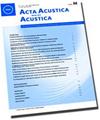Source Localization in a Deep Ocean Using the Time Difference of Multipath Arrivals
Q1 Arts and Humanities
引用次数: 0
Abstract
Bottom bounce is a typical sound propagation mode in deep oceans. A receiver moored below the sea surface receives sound waves transmitted from a submerged source through multipath paths. Four of them which traveled by bottom bounce mode play the leading role in source localization. A passive broadband source localization method is proposed herein based on the four arrival paths and using a single receiver. Through autocorrelation of the signal that is mainly composed of four multipath arrivals, six positive relative time diff erences that are dependent on the source range and depth are acquired via combination. The time diff erences are sorted in an ascending order to form a measured vector. A ray-tracing model is used to predict the replica vector. Then, the source is localized by fitting the replica vector to the measured one. An experiment is conducted in the South China Sea. The proposed method is utilized to successfully localize a source at a depth of 47 m below the surface and at a distance of 13.6 km.基于多径到达时差的深海源定位
海底反弹是深海中典型的声音传播方式。一个停泊在海面以下的接收器接收水下声源通过多径路径发出的声波。其中四个以底部反弹方式传播的波在源定位中起主导作用。提出了一种基于4条到达路径的单接收机无源宽带源定位方法。通过对主要由四个多径到达组成的信号进行自相关,通过组合获得六个依赖于源距离和深度的正相对时间差。时差按升序排序,形成一个测量向量。射线追踪模型用于预测复制向量。然后,通过将复制向量拟合到测量向量上来定位源。在南海进行了一项实验。利用所提出的方法成功地定位了地表以下47 m、距离13.6 km处的震源。
本文章由计算机程序翻译,如有差异,请以英文原文为准。
求助全文
约1分钟内获得全文
求助全文
来源期刊
CiteScore
2.60
自引率
0.00%
发文量
0
审稿时长
6.8 months
期刊介绍:
Cessation. Acta Acustica united with Acustica (Acta Acust united Ac), was published together with the European Acoustics Association (EAA). It was an international, peer-reviewed journal on acoustics. It published original articles on all subjects in the field of acoustics, such as
• General Linear Acoustics, • Nonlinear Acoustics, Macrosonics, • Aeroacoustics, • Atmospheric Sound, • Underwater Sound, • Ultrasonics, • Physical Acoustics, • Structural Acoustics, • Noise Control, • Active Control, • Environmental Noise, • Building Acoustics, • Room Acoustics, • Acoustic Materials and Metamaterials, • Audio Signal Processing and Transducers, • Computational and Numerical Acoustics, • Hearing, Audiology and Psychoacoustics, • Speech,
• Musical Acoustics, • Virtual Acoustics, • Auditory Quality of Systems, • Animal Bioacoustics, • History of Acoustics.

 求助内容:
求助内容: 应助结果提醒方式:
应助结果提醒方式:


